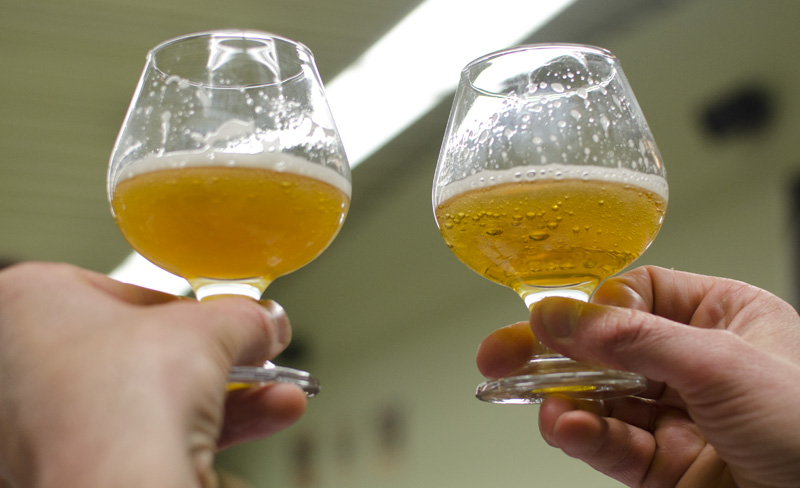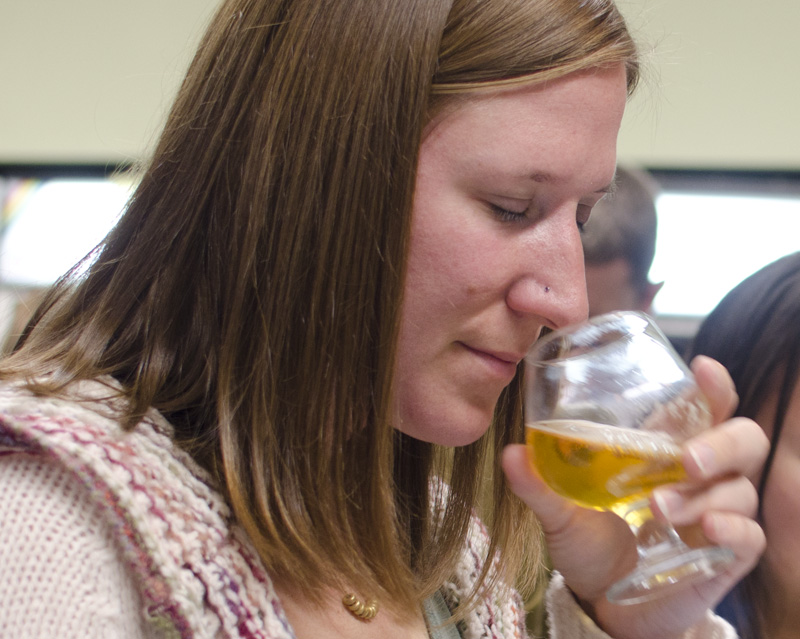Going Blind with Pliny the Elder

Comparing double IPAs—one of which is Russian River’s Pliny the Elder—at a tasting at The Jug Shop in San Francisco. Photo by Jon Page
Almost no one talks bad about Pliny the Elder. Russian River Brewing Co.’s acclaimed double India pale ale has received almost perfect scores at popular beer reviewing sites, like RateBeer.com and BeerAdvocate.com. Gushing fans, jabbing at their keyboards with the beloved hop bomb on their desks, have even gone so far as to call this 8%, 100-IBU ale the best IPA in the world.
But Pliny’s ratings change when the blindfold goes on. In blind tastings of double IPAs, the world’s would-be greatest beer often sinks conspicuously into the middle percentiles of excellence, bringing forth the question: Is Pliny’s reputation built on pillars of hops—or just hype?
Google Pliny the Elder blind tasting and you will receive about 15,000 results in less than half a second. A common outcome in many of the accounts described online might surprise many: Pliny the Elder doesn’t often win. Indeed, it’s becoming increasingly accepted that Pliny the Elder’s reputation is generated by scarcity and hype (combined with the fact that it’s a very respectable beer). A similar recipe of hops, hype and even more frugal production is used to make Pliny the Younger, the triple IPA Russian River releases every February to crowds of fanatics who queue up for hours outside the brewery and select tap houses that serve the beer.
At The Jug Shop, a beverage retailer in San Francisco, beer and spirits manager Eric Cripe hosts an annual blind tasting of IPAs and double IPAs. Pliny the Elder has been in the lineup at each event, but in four tastings from 2011 to 2014, Pliny never won.
Along with Jon Page of All About Beer Magazine, I attended this year’s event, which included about 50 participants who would taste 16 mystery beers—eight IPAs and eight double IPAs—over several rounds of competition before narrowing them all down to the winner from each category. Among the attendees were Dan and Jeff Huck. The brothers had flown from Missouri to drink Pliny the Younger on tap during San Francisco Beer Week and to go home with bottles (even if they were empty) of the Elder. Pliny the Elder, Jeff explained, stands out for its brilliant flash of hops that fades so rapidly a moment later that even an attentive drinker may be left speechless to describe it. “You can’t beat Pliny the Elder,” he said affirmatively.
Attendee David Heilbronn of San Francisco told me he’d spent at least a few hours of Beer Week hunting the city for a draft pour of Pliny the Younger. He eventually got a taste, his first ever. Heilbronn shrugged: It was a good beer, he said, but in the end probably not worth all the trouble it takes to get a glass.

A woman smells a beer at a blind tasting of IPAs and double IPAs at The Jug Shop in San Francisco. Photo by Jon Page
At The Jug Shop, the beers were served two at a time from pitchers into snifters. Only the staff knew what beers were on the roster. Beers were pitted head to head in a tournament of eight beers. We drank through eight IPAs. Then, on the first round of double IPAs, Jeff Huck’s face lit up on the beer marked as number nine. “That’s Pliny!” he said. Jon and I each raised an eyebrow, dubious—or maybe impressed.
Our own capacities to taste and smell were gone, and surely, others were similarly fatigued by alcohol. Drunkenness encroached on the night as the scholastic mood turned jolly. The crowd grew louder. Dropped snifters shattered, followed by applause. Taste buds grew numb and number—and judgments were made at each round, eliminating the beers one by one on the premise that one was better than another.
After more than two hours of drinking, the game was up. AleSmith had survived each round of competition to take first place among the single IPAs, and in a first-ever outcome for Cripe’s annual tasting, beer number nine—Pliny the Elder, as Huck had said—was selected as the best double IPA.
Was the outcome just random chance? Jon and I thought so. Four other double IPAs won the event in prior years. Now, it seemed, Pliny had drawn the lucky straw.
But Cripe, who concedes that his tasting is hardly a perfect system of elimination, still believes it produces valid winners. Pliny the Elder has never won his event not because his guests were too drunk to taste excellence but because the hopheads who bought tickets for the tasting were typically on the lookout for the biggest, bitterest, loudest IPAs in the lineup, Cripe says. He suspects they disregarded the subtler tropical fruit notes of Pliny. But this year, says Cripe, Pliny won because beer preferences have changed. That is, the relatively modest hop profile of Pliny the Elder, built more on balance than bigness, has become the preferred style of hopheads.
“Until now, people just weren’t conditioned,” Cripe says. “Now, Pliny the Elder is the standard that people judge other double IPAs by.”
Vinnie Cilurzo, the man who makes Pliny and owner of Russian River Brewing Co., says he isn’t worried about his beer’s performance in contests, most of which, he notes, are won by other beers. Nor does he modify the beer’s recipe over time to keep pace with evolving tastes. Cilurzo, however, does acknowledge he’s proud that his beer is often credited as the first double IPA.
That, in fact, may be a chief reason for the beer’s tremendous fame. Now, there are hundreds of double IPAs, if not thousands, and one could speculate—just speculate—that if Cilurzo had introduced Pliny the Elder into today’s crowded market, the beer might never have become the star it is.
But let’s not continue down that road. You don’t talk bad about Pliny the Elder.
RELATED: Pliny the Younger and the Birth of ‘Cult Pours’
Alastair Bland is a freelance journalist who lives in San Francisco. When he isn’t reporting on fisheries, agriculture and the environment, he writes about beer. His work appears regularly at Smithsonianmag.com, NPR’s food blog The Salt and the Sacramento News and Review.

I do not rate beers. Following is a list of beers I find equal to Pliny in some cases better.
90 Minute IPA
Hopslam
Enjoy by
Maharaja
Hercules
On a single note give me a Sculpin anytime…..
My favourite thing about Pliny the Elder is that it is the perfect match of hops and malts, each shine quite perfectly in that beer without over powering each other yet you can distinctly taste both in an order that just seems right. So many are over the top, like Heady Topper for instance, but Pliny is a little piece of perfection.
i think the ending hits what is going on with Pliny perfectly. Vinnie hasn’t changed the recipe for Pliny the Elder, but since he introduced it a LOT of other breweries have taken it as inspiration to make their offerings better. And with the number of Double/Imperial IPAs out there now, is it any wonder that at least a few of them have reached their goal?
Pliny is a great example of a double IPA. However, there are plenty of other great examples of double IPAs. Exclusivity is what makes Pliny so desirable. Much like Westvleteren 12 and 8. They are good, but the fact they are so hard to get makes them amazing! As long as RR continues to use great ingredients, and keeps that small, craft beer mentality, Pliny will always be a more desirable double IPA. We put it up against Fat Head’s Head Hunter IPA, and 3 hop heads choose Head Hunter over Pliny. But will I always drink a Pliny when available? Absolutely – which living in FL doesn’t happen very often – also why I look forward to every sip I get! Cheers!
I’m curious which beers beat Pliny the previous times. My first thoughts after trying both Elder and Younger were that they were really good but there was no justifying the hype. Since then, though, I find myself constantly comparing all imperial IPAs to these two beers. When I’m in a hop-forward frame of mind, these are the two beers I think of (along with Blind Pig). They’ve had a long lasting impact and no other hoppy beer has even come close.
I’ve held seven separate tastings over the past ten years, each of which combined beverage industry professionals with enthusiastic beer fans, many of whom professed to love Pliny. Pliny was the only beer that was served in all seven tastings. In NONE of them did Pliny finish higher than fourth (twice) and was dead last three times, out of a field of either seven or eight Double-Imperial IPAs. There was also a space on the scoring sheet for anyone who wanted to try to identify any of the beers. Pliny was identified as Oskar Blues “Gubna” three times and as Great Divide “Hercules” twice. Mo one guessed Pliny. The reactions to the tastings ranged from irritation to affirmation of what tasters already knew: that Pliny’s appeal lies in the beer snob factor of scarcity coupled with buzz. Pliny is, as you noted, a really fine beer. But in NO way does its flavor, body, and even hoppiness merit the wild frenzy it generates. I’ve said for years that if RRBC ever once managed to satisfy the entire demand for Pliny, it would instantly lose all its cachet.